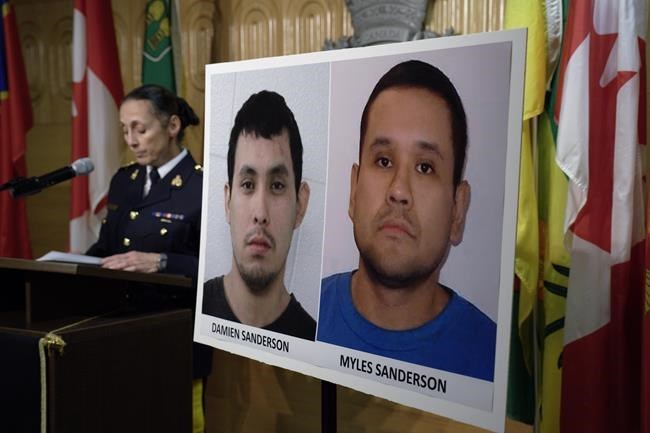OTTAWA — The RCMP’s use of emergency alerts and public updates during their hunt for a stabbing suspect in Saskatchewan has prompted positive reviews from law enforcement experts, who see the moves as a sign the police force is learning from past mistakes.
Residents of the James Smith Cree Nation and surrounding communities were woken early Sunday to a dangerous persons alert that the Mounties say was issued 92 minutes after they started receiving calls about multiple stabbings in the area.
The Mounties soon after released the names and photos of two suspects, one of whom has since been found dead, and have issued several more alerts in Saskatchewan, Alberta and Manitoba as the hunt for the other suspect, Myles Sanderson, continues.
While experts say the RCMP’s communication efforts have not been perfect, the use of emergency alerts and public updates during the search for Sanderson has stood in sharp contrast to past manhunts.
That includes what many see as the Mounties’ failure in Nova Scotia in 2020, when the force was slow to warn the public and release information during a 13-hour shooting rampage that left 23 people dead, including the gunman.
“The Saskatchewan RCMP have done a much more thorough and effective job than was the case in (Nova Scotia), where the main communication was by Twitter and late in the day,” said Wayne MacKay, professor emeritus of law at Dalhousie University.
RCMP officers told a public inquiry earlier this year that they worried issuing an alert during the 2020 shootings in Nova Scotia would have caused a “frantic panic” among the public and put officers in danger.
But experts on emergency alert systems have disputed such assertions, while family members of the victims have said lives could have been saved had people been notified earlier.
Former RCMP sergeant Bruce Pitt-Payne noted the force was also criticized for not providing more information as they hunted for two suspects accused of killing three people in northern British Columbia in 2019.
Following the public attention and criticism in those two previous manhunts, Pitt-Payne said RCMP officers would have been “under the gun” to get information out immediately.
While attempts to assess the RCMP’s performance in Saskatchewan are based largely on what the Mounties themselves claim to know, Pitt-Payne said the emergency alert is proof that some lessons have been learned.
“It came out in a fairly speedy manner,” he said. “Some people are saying it still took an hour and a bit or whatever to get an alert out. But I want to also caution that incorrect information being broadcast simply to get it out early doesn't help anybody either.”
There have also been signs of greater co-operation and communication with local police forces than in previous incidents, said Michael Boudreau, criminology professor at St. Thomas University in Fredericton, N.B.
“Here we see the RCMP hopefully learning from the mistakes in Nova Scotia and reaching out to Regina city police in particular and asking for assistance,” Boudreau said.
The sheer number of public alerts issued by the police as they have hunted for Sanderson has actually prompted some complaints, which Brandon University sociology professor Chris Schneider suggests is a positive development for the RCMP.
Yet Schneider, who has published a book on policing and social media, suggested the Mounties still have a way to go when it comes to engaging the public online, which is where many people go looking for more information when they receive an alert.
Schneider contrasted the RCMP’s approach, which has involved issuing staid statements, with that of the Regina Police Service, which has used social media to respond to questions and posted video updates of Chief Evan Bray speaking directly to the public.
“By using these social media platforms and communications strategies in ways that are appropriate to the situation and connect and establish the police with the community, that reinforces trust,” he said.
Experts say that social media and instant communication have put new pressures on police, and that more attention needs to be placed on developing policies and investing resources in the area.
The RCMP, which promised to develop a national policy providing guidance on the use of emergency alerts after the Nova Scotia shootings, says that policy came into force on March 1. It calls for the creation of a public alert coordinator position in each division, and outlines in broad strokes the circumstances in which a public alert can be used, including active shooter situations, terrorist attacks, riots and natural disasters.
“We've moved into a new age where just communicating and keeping the rest of the public safe and all these kinds of things is in itself a major task, and that is one that can't easily be handled by the traditional front line responders,” MacKay said.
“So maybe they need to think about whether they have the right people in the communications aspects of their forces these days, and whether they have the resources that they need there.”
This report by The Canadian Press was first published Sept. 7, 2022.
— With files from Brett Bundale in Halifax.
Lee Berthiaume, The Canadian Press




